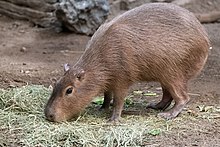Capybara
[4] The genus name, hydrochoerus, comes from Greek ὕδωρ (hydor "water") and χοῖρος (choiros "pig, hog") and the species name, hydrochaeris, comes from Greek ὕδωρ (hydor "water") and χαίρω (chairo "feel happy, enjoy").[7] Since 2002, molecular phylogenetic studies have recognized a close relationship between Hydrochoerus and Kerodon, the rock cavies,[8] supporting placement of both genera in a subfamily of Caviidae.[9][10] This is largely due to the recognition that capybara molar teeth show strong variation in shape over the life of an individual.[23] Capybaras are herbivores, grazing mainly on grasses and aquatic plants,[14][24] as well as fruit and tree bark.[27] Capybaras are autocoprophagous,[28] meaning they eat their own feces as a source of bacterial gut flora, to help digest the cellulose in the grass that forms their normal diet, and to extract the maximum protein and vitamins from their food.[30] The maximum lifespan of the capybara is 8 to 10 years,[31] but in the wild capybaras usually do not live longer than four years because of predation from South American big cats such as jaguars and cougars and from non-mammalian predators such as harpy eagles, caimans, green anacondas and piranhas .Capybaras scent-mark by rubbing their morrillos on objects, or by walking over scrub and marking it with their anal glands.[39] Capybaras are not considered a threatened species;[1] their population is stable throughout most of their South American range, though in some areas hunting has reduced their numbers.[14][19] Capybaras are hunted for their meat and pelts in some areas,[40] and otherwise killed by humans who see their grazing as competition for livestock.[19] Capybaras are docile and usually allow humans to pet and hand-feed them, but physical contact is normally discouraged, as their ticks can be vectors to Rocky Mountain spotted fever.[41] The European Association of Zoos and Aquaria asked Drusillas Park in Alfriston, Sussex, England, to keep the studbook for capybaras, to monitor captive populations in Europe.This inspired social media users to jokingly adopt the capybara as a symbol of class struggle and communism.[48][49] Brazilian Lyme-like borreliosis likely involves capybaras as reservoirs and Amblyomma and Rhipicephalus ticks as vectors.[51] The capybaras have influenced an anime character named Kapibara-san, and a series of merchandise such as plush toys.[citation needed] A common meme format includes capybaras in various situations with the song "After Party" by Don Toliver.[55][better source needed] Capybaras are also associated with the phrase "Ok I pull up", the opening lyric in Toliver's song.



Capybara (disambiguation)PetrópolisConservation statusLeast ConcernIUCN 3.1Scientific classificationEukaryotaAnimaliaChordataMammaliaRodentiaCaviidaeHydrochoerusBinomial nameLinnaeusSynonymsSouth Americaextantlesser capybaraguinea pigsrock caviesagoutichinchillanutriaHydrochoerinaeKerodonNeochoeruswithersllanosdental formulawebbedvestigialkaryotypeCattle tyrantsemiaquaticFloridaCentral Coast of Californialate PleistoceneHydrochoerus hesperotiganitesCaliforniaHydrochoerus gaylordiGrenadaFranklin Park Zooherbivoresaquatic plantsautocoprophagousgut floracellulosevitamin Cgum diseasescurvybig catsjaguarscougarsharpy eaglescaimansgreen anacondaspiranhasgregariousscent glandsanal glandsestrusgestationAlloparentingMato GrossovectorsRocky Mountain spotted feverEuropean Association of Zoos and AquariaDrusillas ParkAlfristonSussexstudbookHoly Weekgenerally forbiddenPapal bullNordeltaBuenos Airesclass strugglecommunismborreliosisAmblyommaRhipicephalusIzu Shaboten Zoohot spring bathsplush toysmeme cultureAfter PartyDon ToliverJosephoartigasia monesiKurloff cellCapybara WalkingEadweard MuybridgeIUCN Red List of Threatened SpeciesWayback MachineNovo Dicionário da Língua PortuguesaWilson, D.E.Darwin, Charles R.Narrative of the surveying voyages of His Majesty's Ships Adventure and Beagle between the years 1826 and 1836, describing their examination of the southern shores of South America, and the Beagle's circumnavigation of the globe. Journal and remarks. 1832–1836Henry ColburnSmithsonian National Zoological ParkLos Angeles TimesProceedings of the National Academy of Sciences of the United States of AmericaRevista de Biología TropicalBibcodeBehavioral EcologyNew York SunKnow Your MemeTheGuardian.comReutersQuartzWikisource1911 Encyclopædia BritannicaWikispeciesCaviidae (Cavies)HystricomorphaCaviinaeBrazilian guinea pig (Cavia aperea)Shiny guinea pig (Cavia fulgida)Santa Catarina´s guinea pig (Cavia intermedia)Greater guinea pig (Cavia magna)Guinea pig (Cavia porcellus)Montane guinea pig (Cavia tschudii)Yellow-toothed cavy (Galea flavidens)Lowland yellow-toothed cavy (Galea leucoblephara)Common yellow-toothed cavy (Galea musteloides)Spix's yellow-toothed cavy (Galea spixii)